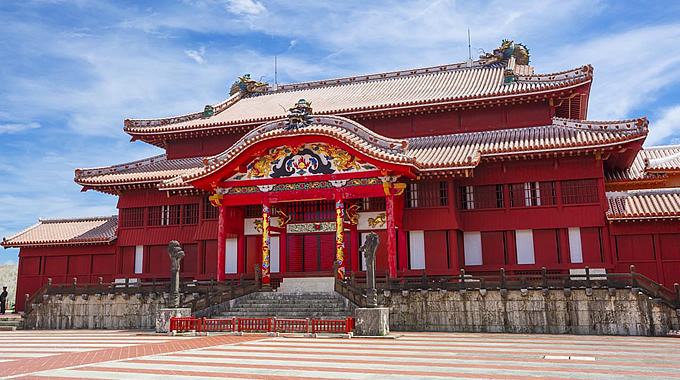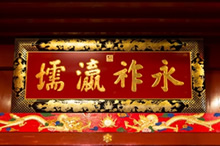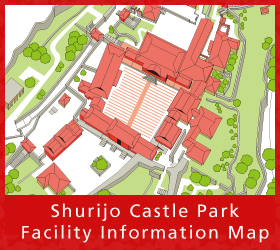Seiden
Home > Main facilities in the Bygone Days > Seiden
Seiden

The Seiden is the largest wooden structure from the Ryukyu Kingdom and was also referred to as the Kokuden meaning national palace, or Momourasoe-Udun which, as it can be defined, a palace (Udun) that governed the numerous towns (Momo Ura Soe) across the land. The Seiden was the symbol and the most important structure in the kingdom.
The Seiden is a two-layer structure with three floors. This architectural style and the lavishly decorated dragon pillars are unparalleled even in China and Japan, and can be described as something that is very unique to the Ryukyus.
The walls and other painted surfaces of the Shurijo Seiden are coated with tung oil. Parts of the base are lacquer.
The Shurijo Seiden Interior and the Interior Engravings
Needless to say, the Seiden is the centerpiece of Shurijo Castle.
The first floor of this three-story structure is called Shichagui, which was mainly used as a place where the king himself conducted political duties and ceremonies. The second floor is called Ufugui and was where the king, his family, and the court ladies conducted ceremonies and rituals. The third floor was an attic for ventilation purposes.
From the excavation survey conducted before the restoration work, the construction of the Seiden is believed to have been around the late 14th century. After its initial construction, the structure was destroyed in several fires, and each time, it was rebuilt at almost the exact location. The structure that was reconstructed in 1992 was modeled after the Seiden which was rebuilt in the early 18th century and which remained standing until it burned down in the Battle of Okinawa.
The Seiden is constructed based on Chinese imperial court and Japanese architectural styles with designs that are unique to the Ryukyus. There are dragon pillars on both sides of the stone steps at the front of the building, and these are called Dairyuchu. Further in from the railing was another pair called Shoryuchu. The dragon symbolized the king and so there were a number of other pillars and beams with dragon engravings throughout Shurijo Castle.
Usasuka

This was where the king’s throne was placed.
The king’s seat was reproduced based on the Ugui portrait of King Sho Shin who reigned from 1477 to 1526.
It is said that to have the Usasuka at the same spot on both the first and second floors is very rare.
In particular, the Usasuka on the second floor had remarkably gorgeous designs, with dragons and auspicious clouds depicted on the columns erected on both sides of the Usasuka.
First Floor of the Seiden

The first floor of the Seiden was called Sichagui, and was mainly used as a place where the king himself conducted political duties and ceremonies.
Behind the sliding doors at the back of the Usasuka are Ochokui, a set of steps exclusively used by the king. The king used those steps to reach the Usasuka from the second floor.
The impressive feature at the center is the Usasuka, the throne where the king arrived to conduct politics and ceremonies. The king’s children and grandchildren sat on both sides of the throne, which was called the Hirausasuka. At the back are stairs that lead to the second floor, and the king used this stairway to descend to the Usasuka.
On the vermilion pillars on both sides of the Usasuka are golden dragons and clouds that are depicted with five colors. The ceiling is rounded with the upper parts folded to add to the formality. According to records, on the floor on both sides were paintings of giraffes and phoenixes.
Second Floor of the Seiden

The second floor of the Seiden was called the Ufugui, and was regularly used by the queen and high-ranking ladies of the court. The Usasuka on the second floor was the throne for the king, and various rituals and ceremonies took place here. During ceremonies, an incense burner, dragon candle stand, decorative golden flowers and Yukimatsu pine and others were placed in the tatami room, and on the wall was a painting of Confucius. In the past, there were numerous framed pieces of writing sent by the Chinese emperors. The framed “中山世土 (Chu Zan Sei Do)” that was displayed, was a piece reproduced from old records.
The form of the altar is similar to that of Shumidan Buddhist altars found in temples. On the panels on the sides are engraved designs of grapes and squirrels. On the front sides of the handrails are a pair of standing golden dragons, and on other fittings are designed with gold inlays on black lacquer.
The room at the front of Usasuka was called the Karahafu, and this was an important place where the king sat in front of the officials lined in rows in the Una for New Year’s ceremonies, and when letters were sent to the Chinese emperor. This was an impressively prestigious space surrounded by dragon décor and Karafu style roof.
The room on the southeast corner was called the Osenmikocha and was where the king and ladies of the court offered prayers every morning toward the eastern direction. In the Otoko was a Shinto shrine where the ladies of the court burnt incense and offered prayers to the Hinukan fire god, and others. This was also where appointment ceremonies for high-ranking priestesses took place with the king and queen in attendance. The third floor was an attic with the main purpose of ventilation.
© Shurijo Castle Park All Rights Reserved.















